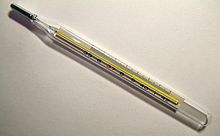| Revision as of 10:18, 7 March 2005 edit203.215.75.74 (talk)No edit summary← Previous edit | Revision as of 10:35, 7 March 2005 edit undoAhoerstemeier (talk | contribs)110,683 editsm Reverted edits by 203.215.75.74 to last version by HarpNext edit → | ||
| Line 12: | Line 12: | ||
| *]s | *]s | ||
| ''See also ]''. | |||
| ] | |||
| ==Medical thermometers== | |||
| ] | |||
| The traditional method of measuring human ]s was with a ] whose tip was inserted either into the mouth ('''oral temperature'''), under the armpit ('''axilliary temperature''') or into the ] via the anus ('''rectal temperature'''). | |||
| Oral temperatures may only be used on patients that are capable of holding the thermometer correctly in their mouth securely, which excludes small children or people who cough too much or vomit (this is now less of a problem with fast-reacting digital thermometers, but was certainly an issue with mercury thermometers taking minutes to register a temperature). Another counter-indication is if the patient has drunk a hot or cold liquid beforehand, in which case one has to wait or use another method. | |||
| In the case of rectal temperatures, insertion, especially by another person than the patient, should be preferably done with ] such as ] (now discouraged) or a ]. Rectal temperatures are the most precise method, in general, but in some cultures (such as the ]) they are found too embarrassing to be applied to patients older than a few years. Rectal temperatures are still often considered the method of choice for ]s. | |||
| In the ], mercury thermometers were found too risky to handle and have largely been replaced with electronic thermometers, or, more rarely, thermometers based on liquids other than mercury. Both kinds may be used orally, axilliarily, or rectally. | |||
| Other kinds of medical thermometers exist: tympanic thermometers measure the temperature of the ] by ] measurement; band thermometers are applied to the patient's brow. | |||
| {{LaboratoryEquipment}} | |||
| ] | |||
| ] | |||
| ] | |||
| ] | |||
| ] | |||
| ] | |||
| ] | |||
| ] | |||
| ] | |||
| ] | |||
| ] | |||
| ] | |||
| ] | |||
Revision as of 10:35, 7 March 2005
A thermometer is a device used to measure temperatures or temperature changes.
Kinds of thermometers
There are many different thermometers relying on different principles. These include:
- Thermistors
- Thermocouples
- Mercury-in-glass thermometers
- Bi-metal mechanical thermometers
- Silicon bandgap temperature sensors
- Infrared thermometers
- Galileo thermometers
See also Timeline of temperature and pressure measurement technology.
Medical thermometers

The traditional method of measuring human body temperatures was with a Mercury-in-glass thermometer whose tip was inserted either into the mouth (oral temperature), under the armpit (axilliary temperature) or into the rectum via the anus (rectal temperature).
Oral temperatures may only be used on patients that are capable of holding the thermometer correctly in their mouth securely, which excludes small children or people who cough too much or vomit (this is now less of a problem with fast-reacting digital thermometers, but was certainly an issue with mercury thermometers taking minutes to register a temperature). Another counter-indication is if the patient has drunk a hot or cold liquid beforehand, in which case one has to wait or use another method.
In the case of rectal temperatures, insertion, especially by another person than the patient, should be preferably done with lubrication such as petroleum jelly (now discouraged) or a water-based personal lubricant. Rectal temperatures are the most precise method, in general, but in some cultures (such as the United States) they are found too embarrassing to be applied to patients older than a few years. Rectal temperatures are still often considered the method of choice for infants.
In the 1990s, mercury thermometers were found too risky to handle and have largely been replaced with electronic thermometers, or, more rarely, thermometers based on liquids other than mercury. Both kinds may be used orally, axilliarily, or rectally.
Other kinds of medical thermometers exist: tympanic thermometers measure the temperature of the tympan by infrared measurement; band thermometers are applied to the patient's brow.
Categories: